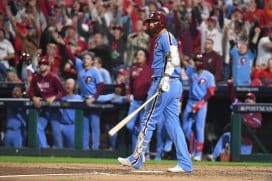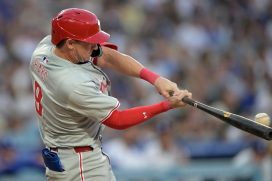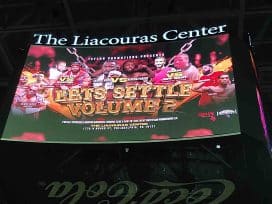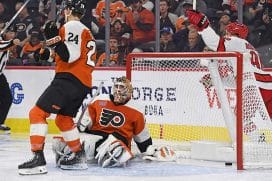Phillies
Top 25 Phillies of All-Time: No. 2 – Grover Cleveland Alexander
By: Matt Alberston, Historical Columnist
“He made me want to throw my bat away when I went to the plate,” said Hall of Fame second baseman Johnny Evers. “He fed me pitches I couldn’t hit. If I let them go, they were strikes. He made you hit bad balls. He could throw into a tin can all day long.”
Evers' words of frustration reflect the amazing abilities of the greatest pitcher in Philadelphia Phillies franchise history – Grover Cleveland Alexander. In a January 1916 article in Baseball Magazine comparing Philadelphia's Alexander and Washington's "Big Train" Walter Johnson, the author proclaims that "Alexander is beyond question the chief of National League hurlers…judged by present standards alone, he is the greatest pitcher on the diamond."
Alexander is the only ballplayer named after a sitting president and later portrayed on film by a future one (Ronald Reagan in The Winning Team). He was born on February 26, 1887 in a small mid-western town of Elba, Nebraska, and was one of 13 children (and one of eight to survive to adulthood.) He grew up on a self-sufficient farm with his family and was a skilled corn shucker, something his father credited with giving him the strong wrists that made his curveball the bane of hitters everywhere.
The young farmboy turned to baseball and earned the reputation of being a good pitcher. He signed on with a minor league team in the Illinois-Missouri League in 1909. But his baseball career nearly ended as soon as it began, when he was struck in the right temple while trying to break up a double play during a July contest. Alexander was unconscious for several days and when he awoke, he immediately suffered from double vision which endured until the next baseball season arrived. Historians postulate that this incident triggered the epileptic attacks that Alexander suffered from for the rest of his life.
That season, Alexander dominated the competition after being traded to the New York State League, posting a 29-11 record and a 1.85 ERA in 345.7 innings of work. The Phillies took notice and subsequently signed him for $500.
Over the next eight years, Alexander won 190 games for the Phillies and posted a 2.18 ERA. In 1915, he led the Phillies to the club's first National League Pennant and first World Series appearance against perennial power, the Boston Red Sox. From 1914 to 1917, Alexander led the National League in wins and helped the Phillies to their best stature in the standings since the club finished in the first division seven times in ten years during the 1890s. However, with America's involvement in World War I looming, the Phillies, fearing their star pitcher would be drafted into service, traded Alexander and first baseman Bill Killefer to the Chicago Cubs for Pickles Dillhoefer, Mike Prendergast and cash.
Alexander was indeed drafted into service where he served in an artillery unit and suffered from shell shock and deafness in his left ear. These injuries and others increased his drinking habits as Alexander became an alcoholic. He continued his pitching duties with the Cubs and later the Cardinals during the twilight of his 20 year major league career. His legacy was cemented during the 1926 World Series against the vaunted New York Yankees. At the age of 40, he pitched complete-game wins in Game 2 and Game 6. In Game 7 on short rest, he entered the game in the seventh inning with the bases loaded, two out and the Cardinals clinging to a 3-2 lead. Tony Lazzeri, who hit 18 home runs and drove in 117 during the regular season, was on deck. When Alexander reached the mound and took the ball from manager Rogers Hornsby, Alexander told Hornsby that he planned to set Lazzeri up with inside fastballs and throw one or two curves over the outside part of the plate. That's exactly what happened as Alexander retired Lazzeri, ending the immediate threat and eventually the game.
Career accomplishments
- Third most wins in Major League history (373)
- Three-time National League pitching Triple Crown winner
- Led the National League in wins in six seasons (five with Phillies)
- Four-time National League ERA champ
- Six-time strikeout champion (five with Phillies)
- Led National League in complete games in six seasons (five with Phillies)
- Led National League in shutouts in seven seasons (five with Phillies)
- Second overall in most wins during a single season in franchise history (1916: 33)
- Third overall in most career wins in franchise history (190)
- 10th overall in most strikeouts in a single season in franchise history (1915: 241)
- Sixth overall in most career strikeouts in franchise history (1,409)
- Second in career complete games in franchise history (219)
- Most single season and career shutouts in franchise history (1916: 16, 61 career)
Most memorable moment
Grover Cleveland Alexander's most recognized moment is his strikeout of Tony Lazzeri with the bases loaded in the 1926 World Series, but he was not a Phillie in 1926, so that moment doesn't qualify for our purposes here.
Alexander's greatest moment of his Phillies tenure was his entire 1915 season. He was by far the best pitcher in baseball that season and led the league with a 31-10 record, a 1.22 ERA, 36 complete games, 12 shutouts, 376.1 innings pitched, and recorded a career high 241 strikeouts. What makes these statistics absolutely astounding was that Alexander pitched home games at Philadelphia's Baker Bowl, a notorious hitters park, with it's looming 40 foot high right field wall a mere 273 feet from home plate.
Baseball Magazine noted in a November 1915 issue that a "case of one-man supremacy…[was]…the Philadelphia Nationals, with Grover Cleveland Alexander as the star. So great was the ascendancy of Alexander that his individual victories not only held that club at the front, but actually kept it from the bottom! Deduct the victories of Alexander, and the Phils, in this closest of all races, would have floundered round seventh and eighth places all summer."
In Game 1 of the 1915 World Series, Alexander sparkled as he pitched a one run complete game, winning the first World Series game in Phillies franchise history. The Phillies dropped Games 2-5 by one run margins, including Alexander's Game 3 start in Boston.
Reasoning for ranking
Alexander recorded seven seasons at 2+ WAR, seven seasons at 5+ WAR, and five season at 8+ WAR, netting him 68 points. His eight years as a Phillie earned him three more points. Additionally, Ol' Pete ranks third in ERA and third in career wins totaling another 10 points, raising his total to 71 points overall.
Previous entries
- No. 25, Garry Maddox
- No. 24, Roy Thomas
- No. 23, Gavvy Cravath
- No. 22, Chris Short
- No. 21, Cy Williams
- No. 20, Curt Schilling
- N0. 19, Cole Hamels
- No. 18, Ryan Howard
- No. 17, Sam Thompson
- No. 16, Del Ennis
- No. 15, Johnny Callison
- No. 14, Jim Bunning
- No. 13, Dick Allen
- No. 12, Billy Hamilton
- No. 11, Sherry Magee
- No. 10, Bobby Abreu
- No. 9, Chuck Klein
- No. 8, Richie Ashburn
- No. 7, Jimmy Rollins
- No. 6, Chase Utley
- No. 5, Robin Roberts
- No. 4, Steve Carlton
- No. 3, Ed Delahanty
Formula explained
The player rankings formula combines both traditional and advanced statistics/metrics and assigns a point total to each category. These statistics only reflect the player's Phillies career.





